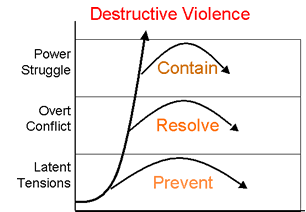What is the Third Side?
The Third Side is a way of looking at the conflicts around us not just from one side or the other but from the larger perspective of the surrounding community. You can have natural sympathies for one side or the other and still choose to take the Third Side.
Taking the Third Side means:
- Seeking to understand both sides of the conflict
- Encouraging a process of cooperative negotiation
- Supporting a wise solution – one that fairly meets the essential needs of both sides and the community
Who are the Thirdsiders?
 Any of us can take the Third Side any time at home, at work, in the community, and in the world.
Any of us can take the Third Side any time at home, at work, in the community, and in the world.
The Third Side is made up of both insiders, such as friends, family, and even the parties themselves, who are in turn actively supported by outsiders, such as neighbors, neutrals, and bystanders.
Think of the Thirdside as five P’s
PEOPLE from the community. Unlike the ultimate arbiter in the form of a king or authoritarian state, the third side is not a transcendent individual or institution who dominates all, but rather the emergent will of the community. It is an impulse that arises from the vital relationships linking each member and every other member of the community.
Using the POWER OF PEERS. The third side possesses the power of peer pressure and the force of public opinion. It is people power. It uses the power of persuasion. It influences the parties primarily through an appeal to their interests and to community norms. In every conflict, there usually exists not just one possible third party but a multitude. Individually, we may not be able to intervene effectively, but collectively we are potentially more powerful than any two conflicting parties. Organizing ourselves into a coalition, we can balance the power between the parties and protect the weaker one.
From a PERSPECTIVE of common ground. While most issues in contention are presented as having just two sides – pro and con, there usually exists a third. From this third perspective, the truth of each competing point of view can be appreciated. Shared interests often come to loom larger than the differences. People remember that they all, in the end, belong to the same extended community.
Supporting a PROCESS of dialogue and nonviolence. Silently or loudly, the Third Side says “No” to violence and “Yes” to dialogue. Thirdsiders urge disputants to sit down and talk out their differences respectfully. They focus, in other words, on the process. To them, how people handle their differences is just as important as what outcome they reach.
Aiming for a PRODUCT of a “Triple Win.” Thirdsiders strive for a resolution that satisfies the legitimate needs of the parties and at the same time meets the needs of the wider community. The goal of the third side is, in other words, a “triple win.”
Working Assumptions
The assumptions that are foundational to the Third Side are a work in progress and like any assumption always open to inquiry.
We invite you to consider that:
- Conflict, in itself, is not a bad thing. Conflict is a natural and healthy process, necessary for making progress and dealing with injustice. The world may actually need more conflict, not less, if the appropriate skills are known and conflict can be managed productively.
- The goal is not to end or eliminate conflict but simply to transform the way it is expressed from destructive forms such as violence, abuse, and intolerance into constructive forms such as debate, dialogue, negotiation, and democracy.Conflict is inevitable; violence is not.
- The way to transform conflict is to create a strong container for creative contention. This container constitutes the Third Side of any conflict. The container can be created by the surrounding community — friends, neighbors, witnesses, neutrals — as well as by the parties themselves.
- You don’t have to take sides in a conflict, nor do you need to be neutral. No matter where your sympathies lie, you can choose to take the Third Side, in other words, the side of the whole whether that is the family, the work organization, the community, or the world.
- You can choose to take the Third Side anytime in the conflicts around you. This means seeking to understand all sides to the conflict, encouraging a peaceful nonviolent process for engaging deep differences, and supporting an inclusive outcome that addresses the essential needs of all.
- Responding to conflicts productively requires courage, preparation, knowledge, skills, creativity and coordination.
- You have an important role to play in transforming the conflicts around you, whether you are one of the parties or a Witness to the conflict. You can make a significant difference.
- By working together in a systemic way, we can create a strong Third Side for even the most intractable conflict. As the old African proverb goes, “When spider webs unite, they can halt even a lion.”
- The Third Side is not a new idea. In some form, it exists in every culture. Indeed it is the most ancient human processes for dealing with deep differences. It does not belong to any group or organization; it is the common heritage of humanity. It belongs to you.




